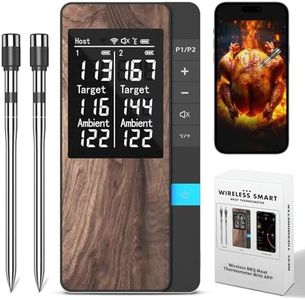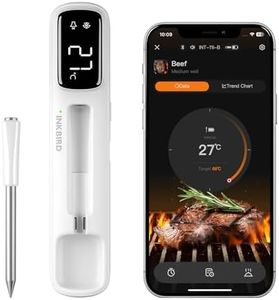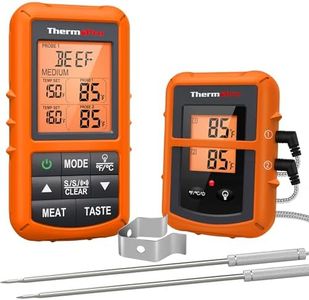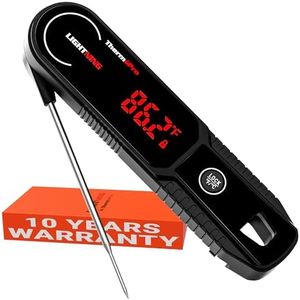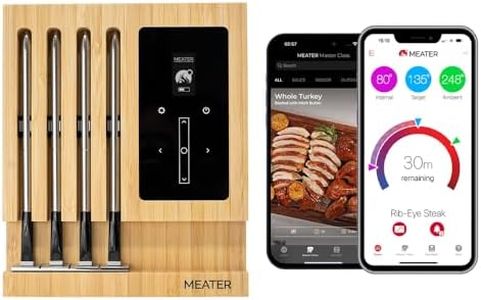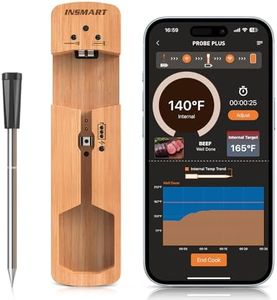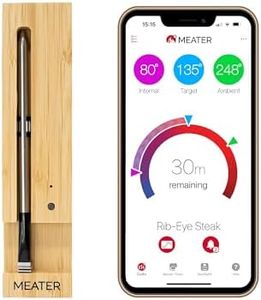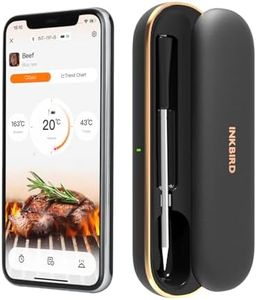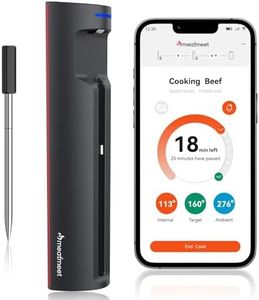We Use CookiesWe use cookies to enhance the security, performance,
functionality and for analytical and promotional activities. By continuing to browse this site you
are agreeing to our privacy policy
10 Best Wireless Meat Thermometers
From leading brands and best sellers available on the web.Buying Guide for the Best Wireless Meat Thermometers
Choosing a wireless meat thermometer is a smart move for anyone who loves grilling, roasting, or smoking meat, because it lets you monitor food temperatures from a distance. This keeps cooking easier, safer, and more accurate, helping you achieve the perfect doneness without constantly opening your grill or oven. When shopping for one, it's important to look at several key specs and understand how they relate to your cooking habits.Wireless RangeWireless range tells you how far you can be from the thermometer’s transmitter and still get accurate readings on your receiver or phone. This is important because a greater range gives you more freedom to move around your home or yard rather than staying close to your grill or oven. Short ranges (about 50-100 feet) work for small apartments or if you’re close to your cooking area, while medium ranges (100-300 feet) are good for bigger homes or backyards. Long ranges (over 300 feet) give the most flexibility for large properties or if you tend to move around a lot. Think about where and how you usually cook to decide how much range you really need.
Number of ProbesThis spec refers to how many different temperatures you can monitor at once. It matters if you cook multiple pieces of meat or different types of food at the same time. A single probe is enough if you cook one thing, but two or more probes let you check both food and grill temperature, or monitor several cuts of meat at once. If you like hosting or preparing different dishes together, more probes will be especially useful.
Temperature AccuracyAccuracy determines how closely the thermometer reads the true temperature. This is important because even a small error can mean undercooked or overcooked meat, impacting taste and safety. Accuracy is usually stated as plus or minus a few degrees. Look for models with a very small margin of error (e.g., within 2°F or 1°C) if you want precise results or cook delicate items. If your cooking is more casual, you might be comfortable with a slightly larger tolerance.
App Connectivity and FeaturesSome wireless meat thermometers use their own receiver, while others connect to a smartphone app via Bluetooth or Wi-Fi. This can be important if you want to use your phone to set timers, get alerts, and track graphs of your cooking. Bluetooth models usually have shorter range but are easy to use, while Wi-Fi models have greater range and might include more advanced features. Choose based on how comfortable you are with technology and whether smart features will enhance your cooking experience.
Battery LifeBattery life tells you how long the device runs before needing new batteries or recharging. This matters especially for long cooks like smoking or roasting bigger cuts. Shorter battery life (a few hours) might be fine for quick grilling, but for low-and-slow cooks, look for a model rated for at least 20-30 hours. Some have rechargeable batteries, which can be convenient if you cook often.
Temperature RangeTemperature range refers to the highest and lowest temperatures your probe can measure, which is important if you want to use it for both slow-cooked meats and high-heat grilling. A wider range lets you use your thermometer for more dishes, from cold-smoking to searing. If you mainly grill steaks, a moderate range is fine, but if you plan to do smoking or candy-making, check for a wider range.
Water and Heat ResistanceThis tells you how well the probes and transmitter can handle exposure to moisture and high temperatures. It’s important because you might be cooking in rain, or needing your thermometer to survive accidental splashes or being left near hot surfaces. Probes are generally heatproof, but check the rated limits, and look for water-resistant or even dishwasher-safe designs if you want easy cleaning and durability.


![[New] MEAT](https://images-proxy.bestreviews.guide/AnhXhgk_aSYDJrVANJgGmv6iGjc=/0x300/https://m.media-amazon.com/images/I/41K-AL+1GGL._AC_CX679_.jpg)
